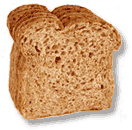|


When
you make this basic bread, you can see many of the principles
of bread science at work.
Recipe
Conversions
|
 CAUTION
CAUTION
Kids, please don’t try this at home without the help
of an adult.
|
|
|
|
|
What
Do I Need?
|
.
|
|
•
1 tablespoon
sugar
• 1 tablespoon olive oil or canola oil (plus a little
extra to grease a bowl)
•
1/2 ounce fresh, active yeast (compressed), at room temperature
•
1 1/4
cup warm water (approximately 80° F)
• 2 1/2 cups all-purpose flour
• 1 cup bread flour
•
1 tablespoon
salt
•
butter (optional)

|
 Did
You Know?
Did
You Know?
That different flours produce different textures? Chef Joan,
who gave us this recipe, likes to combine both all-purpose and
bread flour in this recipe because she says that the all-purpose
flour absorbs more liquid, and results in a fluffy, light texture.
The bread flour has more gluten, which gives the dough elasticity
and makes it more dense.
|
|
• two bowls, preferably ceramic (ceramic bowls conduct
heat more evenly than metal bowls)
• cutting board or marble slab (for kneading dough)
• plastic wrap
• a rolling pin
• a pan
• a towel
• a pastry brush
• a wire rack
|
|
|
|
|
What
Do I Do?
|
|
|
1.
Mix the sugar, oil, and yeast in warm water in a bowl. The
yeast will “bloom” and grow.

|
 Did
You Know?
Did
You Know?
According to Chef Joan, after you crumble the room-temperature
yeast into a bowl with the sugar, oil, and warm water, the
mixture activates. Chefs often refer to this process by saying
the yeast has
“
bloomed,
”
meaning it’s now ready to make dough.
|
|
2.
In another bowl, mix the flours and salt. Put this bowl
aside for a minute.
|
|
|
|
|
|
3.
When the yeast has bloomed, put it and the other liquid
ingredients into the dry ingredients. Mix well.

|
|
|
4.
Put the mixture onto a cutting board or a marble slab
and knead it until the dough comes together and is smooth
and elastic.
|
|
|
|
|
|
5.
Grease a ceramic bowl with olive or canola oil, place
the dough in this bowl, and turn the dough until there’s
a thin coat of oil all over the dough.
|
|
|
|
|
|
6.
Cover the bowl with plastic wrap and place the bowl in
a warm spot.
|
|
|
|
|
|
7.
Wait about an hour, or until the dough doubles in size.
|
 Tip
Tip
When you knead bread by hand, choose a surface that allows
you some leverage; you’ll be using your arms and your
full-body strength to achieve the final texture. Put some
flour on the surface and keep some more nearby‚ as you
may need a light dusting while you’re working.
|
|
|
|
|
8.
After the dough has doubled in size, put it on a lightly floured
surface and punch it down.
|
|
|
|
9.
Knead the dough several times.

|
|
|
|
10.
Roll the dough out into a rectangle, then roll the rectangle
up into a round roll and place it into a well-greased, 9-inch
loaf pan.
|
|
|
|
|
11.
Set the loaf pan in a warm place, cover it lightly with a towel,
and let the dough rise for about 30 minutes. It should almost
double in size.
|
|
|
|
|
|
12.
For a soft crust, use a pastry brush and coat the top of the
dough with butter. For a hard crust, brush the top with water.
|
|
|
|
13.
Bake the bread for about 40 minutes to 1 hour, or until the
top is brown. When you remove the loaf from the pan, it should
sound hollow when you tap it on the bottom.
|
|
|
|
14.
Cool the loaf on a wire rack.
|
|
What’s
Going On?
|
.
|
|
The
warm water reactives the yeast, which begins feeding on the
sugar, creating carbon dioxide as a by-product. Adding water
to the flour forms gluten, which helps hold the carbon dioxide
inside the baking bread, giving it its lofty structure.
|
 Share
& Discuss
Share
& Discuss
Talk about your results.
|
|
|
